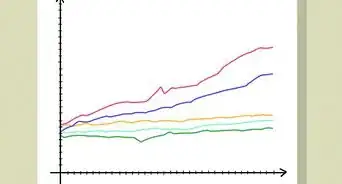This article was co-authored by Ara Oghoorian, CPA. Ara Oghoorian is a Certified Financial Accountant (CFA), Certified Financial Planner (CFP), a Certified Public Accountant (CPA), and the Founder of ACap Advisors & Accountants, a boutique wealth management and full-service accounting firm based in Los Angeles, California. With over 26 years of experience in the financial industry, Ara founded ACap Asset Management in 2009. He has previously worked with the Federal Reserve Bank of San Francisco, the U.S. Department of the Treasury, and the Ministry of Finance and Economy in the Republic of Armenia. Ara has a BS in Accounting and Finance from San Francisco State University, is a Commissioned Bank Examiner through the Federal Reserve Board of Governors, holds the Chartered Financial Analyst designation, is a Certified Financial Planner™ practitioner, has a Certified Public Accountant license, is an Enrolled Agent, and holds the Series 65 license.
There are 36 references cited in this article, which can be found at the bottom of the page.
wikiHow marks an article as reader-approved once it receives enough positive feedback. In this case, 81% of readers who voted found the article helpful, earning it our reader-approved status.
This article has been viewed 2,516,911 times.
It is no coincidence that most wealthy people invest in the stock market. While fortunes can be both made and lost, investing in stocks is one of the best ways to create financial security, independence, and generational wealth. Whether you are just beginning to save or already have a nest egg for retirement, your money should be working as efficiently and diligently for you as you did to earn it. To succeed in this, however, it is important to start with a solid understanding of how stock market investment works. This article will guide you through the process of making investment decisions and put you on the right path to becoming a successful investor. This article discusses investing in stocks specifically. For stock trading, see How to Trade Stocks. For mutual funds, see How to Decide Whether to Buy Stocks or Mutual Funds.
Steps
Establishing Your Goals and Expectations
-
1Make a list of things you want. To set your goals, you’ll need to have an idea of what things or experiences you want to have in your life that require money. For example, what lifestyle do you want to have once you retire? Do you enjoy traveling, nice cars, or fine dining? Do you have only modest needs? Use this list to help you set your goals in the next step. [1]
- Making a list will also help if you are saving for your children’s future. For example, do you want to send your children to a private school or college? Do you want to buy them cars? Would you prefer public schools and using the extra money for something else? Having a clear idea of what you value will help you establish goals for savings and investment.
-
2Set your financial goals. In order to structure an investment plan, you must first understand why you are investing. In other words, where would you like to be financially, and how much do you have to invest to get there? Your goals should be as specific as possible, so that you have the best idea of what you’ll need to do to achieve them. [2]
- Popular financial goals include buying a home, paying for your child’s college, amassing a “rainy day” emergency fund, and saving for retirement. Rather than having a general goal such as “own a home,” set a specific goal: “Save $63,000 for a down-payment on a $311,000 house.” (Most home loans require a down payment of between 20% and 25% of the purchase price in order to attract the most affordable interest rate.) [3]
- Most investment advisers recommend that you save at least ten times your peak salary for retirement.[4] This will allow you to retire on about 40% of your peak pre-retirement annual income, using the 4% safe withdrawal rule.[5] For example, if you retire at a salary of $80,000, you should strive for at least $800,000 saved by retirement, which will provide you with $32,000 annual income at retirement, then adjusted annually for inflation.
- Use a college cost calculator to determine how much you will need to save for your children’s college, how much parents are expected to contribute and the various types of financial aid your children may qualify for, based on your income and net worth. Remember that costs vary widely depending on the location and type of school (public, private, etc.). Also remember that college expenses include not only tuition, but also fees, room and board, transportation, books and supplies. [6]
- Remember to factor time into your goals. This is especially true for long-term projects such as retirement funds. For example: John begins saving at age 20 using an IRA (Individual Retirement Account) earning an 8% return. He saves $3,000 a year for the next ten years, then stops adding to the account but keeps the IRA invested in the market. By the time John is 65, he will have $642,000 built up. [7]
- Many websites have “savings calculators” that can show you how much an investment will grow over a given length of time at a specified interest rate. While they’re not a substitute for professional financial advice, these calculators can give you a good place to start. [8]
- Once you determine your goals, you can use the difference between where you are today and where you want to be to determine the rate of return needed to get there.
- Make sure you consider both your short-term and long-term goals.[9]
Advertisement -
3Determine your risk tolerance. Acting against your need for returns is the risk required to earn them. Your risk tolerance is a function of two variables: your ability to take risks and your willingness to do so.[10] There are several important questions you should ask yourself during this step, such as: [11]
- What stage of life are you in? In other words, are you near the low end or closer to the peak of your income-earning potential?
- Are you willing to accept more risk to earn greater returns?
- What are the time horizons of your investment goals?
- How much liquidity (i.e. resources that can easily be converted to cash) do you need for your shorter-term goals and to maintain a proper cash reserve? Don't invest in stocks until you have at least six to twelve months of living expenses in a savings account as an emergency fund in case you lose your job. If you have to liquidate stocks after holding them less than a year, you're merely speculating, not investing.
- If the risk profile of a potential investment does not conform to your tolerance level, it's not a suitable option. Discard it.
- Your asset allocation should vary based on your stage of life. For example, you might have a much higher percentage of your investment portfolio in stocks when you are younger. Also, if you have a stable, well-paying career, your job is like a bond: you can depend on it for steady, long-term income. This allows you to allocate more of your portfolio to stocks. Conversely, if you have a "stock-like" job with unpredictable income such as investment broker or stock trader, you should allocate less to stocks and more to the stability of bonds. While stocks allow your portfolio to grow faster, they also pose more risks. As you get older, you can transition into more stable investments, such as bonds. [12]
-
4Learn about the market. Spend as much time as you can reading about the stock market and the larger economy. Listen to the insights and predictions of experts to develop a sense of the state of the economy and what types of stocks are performing well. There are several classic investment books that will give you a good start:
- The Intelligent Investor and Security Analysis by Benjamin Graham are excellent starter texts on investing.
- The Interpretation of Financial Statements by Benjamin Graham and Spencer B. Meredith. This is a short and concise treatise on reading financial statements.
- Expectations Investing, by Alfred Rappaport, Michael J. Mauboussin. This highly readable book provides a new perspective on security analysis and is a good complement to Graham's books.
- Common Stocks and Uncommon Profits (and other writings) by Philip Fisher. Warren Buffett once said he was 85 percent Graham and 15 percent Fisher, and that is probably understating the influence of Fisher on shaping his investment style.
- "The Essays of Warren Buffett," a collection of Buffett's annual letters to shareholders. Buffett made his entire fortune investing, and has lots of very useful advice for people who'd like to follow in his footsteps. Buffett has provided these to read online free: www.berkshirehathaway.com/letters/letters.html.
- The Theory of Investment Value, by John Burr Williams is one of the finest books on stock valuation.
- One Up on Wall Street and Beating the Street, both by Peter Lynch, a highly successful money manager. These are easy to read, informative and entertaining.
- Extraordinary Popular Delusions and the Madness of Crowds by Charles Mackay and Reminiscences of a Stock Operator by William Lefevre use real-life examples to illustrate the dangers of emotional overreaction and greed in the stock market.
- You can also enroll in basic or beginner investment courses offered online. Sometimes these are offered free by financial companies such as Morningstar and T.D. Ameritrade. [13] Several universities, including Stanford and MIT, offer online investment courses.[14] [15]
- Community centers and adult education centers may also offer financial courses. These are often low-cost or free and can provide you with a solid overview of investment. Look online to see if there are any in your area.
- Practice by “paper trading.” Pretend to purchase and sell stocks, using the closing prices each day. You can literally do this on paper, or you can sign up for a free practice account online at places such as How the Market Works. Practicing will help you hone your strategy and knowledge without risking real money.
-
5Formulate your expectations for the stock market. Whether you are a professional or a novice, this step is difficult, because it is both art and science. It requires that you develop the ability to assemble a tremendous amount of financial data about market performance. You also must develop “a feel” for what these data do and do not signify.
- This is why many investors buy the stock of products that they know and use. [16] Consider the products you own in your home. From what’s in the living room to what’s inside the refrigerator, you have first-hand knowledge of these products and can quickly and intuitively assess their performance compared with that of competitors.
- For such household products, try to envision economic conditions that might lead you to stop purchasing them, to upgrade, or to downgrade.
- If economic conditions are such that people are likely to buy a product you are very familiar with, this might be a good bet for an investment.
-
6Focus your thinking. While trying to develop general expectations about the market and the types of companies that might be successful given present or expected economic conditions, it's important to establish predictions in some specific areas including:
- The direction of interest rates and inflation, and how these may affect any fixed-income or equity purchases. [17] When interest rates are low, more consumers and businesses have access to money. Consumers have more money to make purchases, so they usually buy more. This leads to higher company revenues, which allows companies to invest in expansion. Thus, lower interest rates lead to higher stock prices. In contrast, higher interest rates can decrease stock prices. High interest rates make it more difficult or expensive to borrow money. Consumers spend less, and companies have less money to invest. Growth may stall or decline. [18]
- The business cycle of an economy, along with a broad macroeconomic view. Inflation is an overall rise in prices over a period of time. Moderate or “controlled” inflation is usually considered good for the economy and the stock market. Low interest rates combined with moderate inflation usually have a positive effect on the market. High interest rates and deflation usually cause the stock market to fall.
- Favorable conditions within specific sectors of an economy, along with a targeted microeconomic view. [19] Certain industries are usually considered to do well in periods of economic growth, such as automobiles, construction, and airlines. In strong economies, consumers are likely to feel confident about their futures, so they spend more money and make more purchases. These industries and companies are known as “cyclical.” [20]
- Other industries perform well in poor or falling economies. These industries and companies are usually not as affected by the economy. For example, utilities and insurance companies are usually less affected by consumer confidence, because people still have to pay for electricity and health insurance. These industries and companies are known as “defensive” or “counter-cyclical.” [21]
Making Your Investments
-
1Determine your asset allocations. In other words, determine how much of your money you will put in which types of investments.
- Decide how much money will be invested in stocks, how much in bonds, how much in more aggressive alternatives and how much you will hold as cash and cash equivalents (certificates of deposit, Treasury bills, etc.). [22]
- The goal here is to determine a starting point based on your market expectations and risk tolerance. [23]
-
2Select your investments. Your "risk and return" objectives will eliminate some of the vast number of options. As an investor, you can choose to purchase stock from individual companies, such as Apple or McDonalds. This is the most basic type of investing. A bottom-up approach occurs when you buy and sell each stock independently based on your projections of their future prices and dividends. Investing directly in stocks avoids fees charged by mutual funds but requires more effort to ensure adequate diversification.
- Select stocks that best meet your investment needs. If you are in a high income tax bracket, have minimal short- or intermediate-term income needs, and have high risk tolerance, select mostly growth stocks that pay little or no dividends but have above-average expected growth rates.
- Low-cost index funds usually charge less in fees than actively-managed funds. [24] They offer more security because they model their investments on established, well respected indexes. For example, an index fund might select a performance benchmark consisting of the stocks inside the S&P 500 index. The fund would purchase most or all of the same assets, allowing it to equal the performance of the index, less fees. This would be considered a relatively safe but not terribly exciting investment. Advocates of active stock picking turn their noses up at such investments. [25] Index funds can actually be very good “starters” for new investors.[26] Buying and holding "no-load," low-expense index funds and using a dollar-cost-averaging strategy has been shown to outperform many more-active mutual funds over the long term. Choose index funds with the lowest expense ratio and annual turnover. For investors with less than $100,000 to invest, index funds are hard to beat when viewed within a long time period. See Decide Whether to Buy Stocks or Mutual Funds for more information whether individual stocks or mutual funds are better for you.
- An exchange-traded fund (ETF) is a type of index fund that trades like a stock. ETFs are unmanaged portfolios (where stocks are not continuously bought and sold as with actively managed funds) and can often be traded without commission. You can buy ETFs that are based on a specific index, or based on a specific industry or commodity, such as gold. [27] ETFs are another good choice for beginners.
- You can also invest in actively managed mutual funds. These funds pool money from many investors and put it primarily into stocks and bonds. Individual investors buy shares of the portfolio. [28] Fund managers usually create portfolios with particular goals in mind, such as long-term growth. However, because these funds are actively managed (meaning managers are constantly buying and selling stocks to achieve the fund’s goal), their fees can be higher. Mutual fund expense ratios can end up hurting your rate of return and impeding your financial progress. [29]
- Some companies offer specialized portfolios for retirement investors. These are “asset allocation" or "target date" funds that automatically adjust their holdings based on your age. For example, your portfolio might be more heavily weighted towards equities when you are younger and automatically transfer more of your investments into fixed-income securities as you get older. In other words, they do for you what you might be expected to do yourself as you get older. [30] Be aware that these funds typically incur greater expenses than simple index funds and ETFs, but they perform a service the latter investments do not.
- It’s important to consider transaction costs and fees when choosing your investments. Costs and fees can eat into your returns and reduce your gains. It is vital to know what costs you will be liable for when you purchase, hold, or sell stock. Common transaction costs for stocks include commissions, bid-ask spread, slippage, SEC Section 31 fees [31] , and capital gains tax. For funds, costs may include management fees, sales loads, redemption fees, exchange fees, account fees, 12b-1 fees, and operating expenses. [32]
-
3Determine the intrinsic value and the right price to pay for each stock you are interested in. Intrinsic value is how much a stock is worth, which can be different from the current stock price. The right price to pay is generally a fraction of the intrinsic value, to allow a margin of safety (MOS). MOS may range from 20% to 60% depending on the degree of uncertainty in your intrinsic value estimate. There are many techniques used to value stocks:
- Dividend discount model: the value of a stock is the present value of all its future dividends. Thus, the value of a stock = dividend per share divided by the difference between the discount rate and the dividend growth rate. [33] For example, suppose Company A pays an annual dividend of $1 per share, which is expected to grow at 7% per year. If your personal cost of capital (discount rate) is 12%, Company A stock is worth $1/(.12-.07) = $20 per share.
- Discounted cash flow (DCF) model: the value of a stock is the present value of all its future cash flows. Thus, DCF = CF1/(1+r)^1 + CF2/(1+r)^2 + ... + CFn/(1+r)^n, where CFn = cash flow for a given time period n, r = discount rate. A typical DCF calculation projects a growth rate for annual free cash flow (operating cash flow less capital expenditures) for the next 10 years to calculate a growth value and estimate a terminal growth rate thereafter to calculate a terminal value, then sum up the two to arrive at the DCF value of the stock. For example, if Company A's current FCF is $2/share, estimated FCF growth is 7% for the next 10 years and 4% thereafter, using a discount rate of 12%, the stock has a growth value of $15.69 and a terminal value of $16.46 and is worth $32.15 a share.
- Comparables Methods: These methods value a stock based on its price relative to earnings (P/E), book value (P/B), sales (P/S), or cash flow (P/CF). It compares the stock's current price ratios with an appropriate benchmark and the stock's historic average ratios to determine the price at which the stock should sell.
-
4Purchase your stock. Once you've decided which stocks to buy, it is time to purchase your stocks. Find a brokerage firm that meets your needs and place your orders.
- You can select a discount broker, who will simply order the stocks you want to purchase. You can also choose a full-service brokerage firm, which will cost more but will also provide information and guidance. [34] Do your own due diligence by checking out their websites and looking at reviews online to find the best broker for you. The most important factor to consider here is how much commission is charged and what other fees are involved. Some brokers offer free stock trades if your portfolio meets a certain minimum value (e.g. Merrill Edge Preferred Rewards), or if you invest within a select list of stocks whose companies pay the transaction costs (e.g. loyal3).
- Some companies offer direct stock purchase plans (DSPPs) that allow you to purchase their stock without a broker. If you are planning on buying and holding or dollar cost averaging, this may be your best option. Search online or call or write the company whose stock you wish to buy to inquire whether they offer such a plan. [35] Pay attention to the fee schedule and select the plans that charge no or minimal fees.
-
5Build a portfolio containing between five and 20 different stocks for diversification. Diversify across different sectors, industries, countries, company size, and style ("growth" vs. "value").
-
6Hold for the long term, five to ten years or preferably longer. Avoid the temptation to sell when the market has a bad day, month or year. The long-range direction of the stock market is always up. On the other hand, avoid the temptation to take profit (sell) even if your stocks have gone up 50 percent or more. As long as the fundamental conditions of the company are still sound, do not sell (unless you desperately need the money. It does make sense to sell, however, if the stock price appreciates well above its value (see Step 3 of this Section), or if the fundamentals have drastically changed since you bought the stock so that the company is unlikely to be profitable anymore.
-
7Invest regularly and systematically. Dollar cost averaging forces you to buy low and sell high and is a simple, sound strategy. Set aside a percentage of each paycheck to buy stocks.
- Remember that bear markets are for buying. If the stock market drops by at least 20%, move more cash into stocks. Should the market drop by 50%, move all available discretionary cash and bonds into stocks. That may sound scary, but the market has always bounced back, even from the crash that occurred between 1929 and 1932. The most successful investors have bought stocks when they were "on sale."
Monitoring and Maintaining Your Portfolio
-
1Establish benchmarks. It is important to establish appropriate benchmarks in order to measure the performance of your stocks, as compared to your expectations. Develop standards for how much growth you require of each specific investment in order to consider it worth keeping.
- Typically these benchmarks are based on the performance of various market indexes. These allow you to determine whether your investments are performing at least as well as the market overall.
- It may be counter-intuitive, but just because a stock is going up does not mean it is a good investment, especially if it is going up more slowly than similar stocks. Conversely, not all shrinking investments are losers (when similar investments are doing even worse).
-
2Compare performance to expectations. You must compare the performance of each investment to the expectations you established for it in order to determine its worth. This goes for assessing your other asset allocation decisions as well.
- Investments that do not meet expectations should be sold so your money can be invested elsewhere, unless you have good reason to believe your expectations will soon be met.
- Give your investments time to work out. One-year or even three-year performance is meaningless to the long-term investor. The stock market is a voting machine in the short term and a weighing machine in the long term.
-
3Be vigilant and update your expectations. Once you have purchased stock, you must periodically monitor the performance of your investments. [36]
- Circumstances and opinions change. This is a part of investing. The key is to properly process and assess all new information and implement any changes according to the guidelines set in the previous steps.
- Consider whether your market expectations were correct. If not, why not? Use these insights to update your expectations and investment portfolio.
- Consider whether your portfolio is performing within your risk parameters. It may be that your stocks have done well, but the investments are more volatile and risky than you had anticipated. If you aren't comfortable with these risks, it's probably time to change investments.
- Consider whether you are able to achieve the objectives you set. It may be that your investments are growing within acceptable risk parameters but are growing too slowly to meet your goals. If this is the case, it's time to consider new investments.
-
4Guard against the temptation to trade excessively. After all, you are an investor, not a speculator. In addition, every time you take a profit, you incur capital-gains taxes. Besides, every trade comes with a broker's fee.
- Avoid stock tips. Do your own research and do not seek or pay attention to any stock tips, even from insiders. Warren Buffett says that he throws away all letters that are mailed to him recommending one stock or another. He says that these salesmen are being paid to say good things about a stock so that the company can raise money.
- Don't pay too much attention to media coverage of the stock market. Focus on investing for the long term (at least 20 years), and don't be distracted by short-term price gyrations.[37]
-
5Consult a reputable broker, banker, or investment adviser if you need to. Never stop learning, and continue to read as many books and articles as possible written by experts who have successfully invested in the types of markets in which you have an interest. You will also want to read articles helping you with the emotional and psychological aspects of investing, to help you deal with the ups and downs of participating in the stock market. It is important for you to know how to make the smartest choices possible when investing in stocks, and even when you do make wise decisions you should be prepared to deal with losses in the event that they occur.
What Are Common Mistakes When Starting To Invest?
Expert Q&A
Did you know you can get expert answers for this article?
Unlock expert answers by supporting wikiHow
-
QuestionWhere should I invest when I get my first job?
 Ara Oghoorian, CPAAra Oghoorian is a Certified Financial Accountant (CFA), Certified Financial Planner (CFP), a Certified Public Accountant (CPA), and the Founder of ACap Advisors & Accountants, a boutique wealth management and full-service accounting firm based in Los Angeles, California. With over 26 years of experience in the financial industry, Ara founded ACap Asset Management in 2009. He has previously worked with the Federal Reserve Bank of San Francisco, the U.S. Department of the Treasury, and the Ministry of Finance and Economy in the Republic of Armenia. Ara has a BS in Accounting and Finance from San Francisco State University, is a Commissioned Bank Examiner through the Federal Reserve Board of Governors, holds the Chartered Financial Analyst designation, is a Certified Financial Planner™ practitioner, has a Certified Public Accountant license, is an Enrolled Agent, and holds the Series 65 license.
Ara Oghoorian, CPAAra Oghoorian is a Certified Financial Accountant (CFA), Certified Financial Planner (CFP), a Certified Public Accountant (CPA), and the Founder of ACap Advisors & Accountants, a boutique wealth management and full-service accounting firm based in Los Angeles, California. With over 26 years of experience in the financial industry, Ara founded ACap Asset Management in 2009. He has previously worked with the Federal Reserve Bank of San Francisco, the U.S. Department of the Treasury, and the Ministry of Finance and Economy in the Republic of Armenia. Ara has a BS in Accounting and Finance from San Francisco State University, is a Commissioned Bank Examiner through the Federal Reserve Board of Governors, holds the Chartered Financial Analyst designation, is a Certified Financial Planner™ practitioner, has a Certified Public Accountant license, is an Enrolled Agent, and holds the Series 65 license.
Certified Financial Planner & Accountant
-
QuestionHow do you make money in the stock market?
 Ara Oghoorian, CPAAra Oghoorian is a Certified Financial Accountant (CFA), Certified Financial Planner (CFP), a Certified Public Accountant (CPA), and the Founder of ACap Advisors & Accountants, a boutique wealth management and full-service accounting firm based in Los Angeles, California. With over 26 years of experience in the financial industry, Ara founded ACap Asset Management in 2009. He has previously worked with the Federal Reserve Bank of San Francisco, the U.S. Department of the Treasury, and the Ministry of Finance and Economy in the Republic of Armenia. Ara has a BS in Accounting and Finance from San Francisco State University, is a Commissioned Bank Examiner through the Federal Reserve Board of Governors, holds the Chartered Financial Analyst designation, is a Certified Financial Planner™ practitioner, has a Certified Public Accountant license, is an Enrolled Agent, and holds the Series 65 license.
Ara Oghoorian, CPAAra Oghoorian is a Certified Financial Accountant (CFA), Certified Financial Planner (CFP), a Certified Public Accountant (CPA), and the Founder of ACap Advisors & Accountants, a boutique wealth management and full-service accounting firm based in Los Angeles, California. With over 26 years of experience in the financial industry, Ara founded ACap Asset Management in 2009. He has previously worked with the Federal Reserve Bank of San Francisco, the U.S. Department of the Treasury, and the Ministry of Finance and Economy in the Republic of Armenia. Ara has a BS in Accounting and Finance from San Francisco State University, is a Commissioned Bank Examiner through the Federal Reserve Board of Governors, holds the Chartered Financial Analyst designation, is a Certified Financial Planner™ practitioner, has a Certified Public Accountant license, is an Enrolled Agent, and holds the Series 65 license.
Certified Financial Planner & Accountant
Warnings
- Invest only money you can afford to lose. Stocks can go down sharply over the short term, and even an investment that appears smart can go bad.⧼thumbs_response⧽
- Do not attempt to time the market by guessing when stocks are ready to reverse direction. Nobody (other than liars) can time the market.⧼thumbs_response⧽
- Do not use technical analysis, which is a technique for traders, not investors. Its viability as an investment tool is debated long and loudly.⧼thumbs_response⧽
- Stick with stocks, and stay away from options and derivatives, which are speculations, not investments. You are more likely to do well with stocks. With options and derivatives you are far more likely to lose money.⧼thumbs_response⧽
- When it comes to money, people may lie to save their pride. When someone gives you a hot tip, remember that it is just an opinion. Consider the source.⧼thumbs_response⧽
- Do not buy stocks on margin. Stocks may fluctuate widely without notice, and using leverage can wipe you out. You don't want to buy stocks on margin, watch stocks plunge 50 percent or so, wiping you out, and then bounce right back. Buying stocks on margin is not investing, but speculating.⧼thumbs_response⧽
- Don't blindly trust the investment advice of anyone, especially someone who will make money from your trades. This could apply to brokers, advisers or analysts.⧼thumbs_response⧽
- Do not day-trade, swing-trade, or otherwise trade stocks for very short-term profits. Remember, the more frequently you trade, the more commissions you incur, which will reduce any gains you make. Also, short-term gains are taxed more heavily than long-term (more than one-year) gains. The best reason to avoid ultra-short-term trades is that success in that area requires a great deal of skill, knowledge and nerve, to say nothing of luck. It is not for the inexperienced.⧼thumbs_response⧽
- Don't blindly feed the dogs. In other words, do not buy stocks that have had low returns and appear cheap. Most cheap stocks are cheap for a reason. Just because a stock that was trading at above $100 and is now trading at $1 does not mean that it can't possibly go lower. All stocks can go to zero, and many have.⧼thumbs_response⧽
- Avoid "momentum investing", the practice of buying the hottest stocks that have had the biggest run recently. This is pure speculation, not investing, and it does not work consistently. Just ask anyone who tried it with the hottest tech stocks during the late 1990s.⧼thumbs_response⧽
- Stock market returns have annualized 10% before inflation and 7% after inflation for over 100 years,[40] but can be extremely variable from year to year. From 2000-2015, for example, the compound annual growth rate of the S&P 500 was 4.2%. Don't count on 10% return, if you are investing for a short time frame, or if you are also invested in bonds and alternative investments, which have lower expected returns. Furthermore, remember that past performance does not guarantee future returns.⧼thumbs_response⧽
- Do not engage in insider trading. If you trade stocks using inside information before the information is made public, you may face prosecution for felony crimes. No matter how much money you could potentially make, it is insignificant compared to the legal troubles you could get into.[41]⧼thumbs_response⧽
References
- ↑ http://money.cnn.com/magazines/moneymag/money101/lesson1/index2.htm
- ↑ http://money.usnews.com/money/blogs/the-smarter-mutual-fund-investor/2013/11/15/set-your-goals-and-check-your-risk-before-investing
- ↑ http://money.usnews.com/money/personal-finance/articles/2014/04/07/alternatives-to-putting-20-down-on-a-home
- ↑ http://www.theatlantic.com/business/archive/2015/10/retirement-savings-enough/410032/
- ↑ https://en.wikipedia.org/wiki/Trinity_study
- ↑ http://money.cnn.com/tools/collegecost/collegecost.html
- ↑ http://money.cnn.com/magazines/moneymag/money101/lesson1/index2.htm
- ↑ http://money.cnn.com/tools/savingscalc/savingscalc.html
- ↑ Ara Oghoorian, CPA. Certified Financial Planner & Accountant. Expert Interview. 11 March 2020.
- ↑ Ara Oghoorian, CPA. Certified Financial Planner & Accountant. Expert Interview. 11 March 2020.
- ↑ http://www.investopedia.com/articles/pf/07/risk_tolerance.asp
- ↑ http://money.cnn.com/retirement/guide/investing_basics.moneymag/index7.htm
- ↑ http://www.morningstar.com/cover/Classroom.html
- ↑ http://online.stanford.edu/course/rauh-finance
- ↑ http://ocw.mit.edu/courses/find-by-topic/#cat=business&subcat=finance
- ↑ http://www.investopedia.com/financial-edge/1010/how-to-invest-in-everyday-products.aspx
- ↑ http://www.investopedia.com/articles/stocks/09/how-interest-rates-affect-markets.asp
- ↑ http://www.forbes.com/sites/mikepatton/2014/05/27/how-rising-interest-rates-could-affect-your-portfolio/
- ↑ http://www.investopedia.com/articles/economics/08/understanding-microeconomics.asp
- ↑ http://marketrealist.com/2014/02/investors-guide-cyclical-counter-cyclical-industries/
- ↑ http://marketrealist.com/2014/02/investors-guide-cyclical-counter-cyclical-industries/
- ↑ http://www.sec.gov/investor/pubs/assetallocation.htm
- ↑ http://www.sec.gov/investor/pubs/assetallocation.htm
- ↑ http://www.forbes.com/sites/thebogleheadsview/2013/05/23/index-funds-low-fees-arent-the-only-advantage/
- ↑ http://www.forbes.com/sites/mitchelltuchman/2013/07/12/what-is-an-index-fund-investing-basics/
- ↑ https://investor.vanguard.com/mutual-funds/index-funds
- ↑ http://www.forbes.com/sites/feeonlyplanner/2013/07/18/whats-the-difference-mutual-funds-and-exchange-traded-funds-explained/
- ↑ http://investor.gov/investing-basics/investment-products/mutual-funds
- ↑ http://www.sec.gov/answers/mffees.htm
- ↑ https://www.fidelity.com/mutual-funds/asset-allocation-funds/overview
- ↑ http://www.sec.gov/answers/sec31.htm
- ↑ http://www.sec.gov/answers/mffees.htm
- ↑ http://www.investopedia.com/terms/d/ddm.asp
- ↑ http://www.kiplinger.com/article/investing/T038-C000-S002-should-i-use-a-discount-broker-or-a-full-service-b.html
- ↑ http://www.forbes.com/sites/moneybuilder/2012/06/20/how-to-invest-using-direct-stock-purchase-plans/
- ↑ http://www.nd.gov/ndpers/forms-and-publications/publications/monitor-investment-performance.pdf
- ↑ Ara Oghoorian, CPA. Certified Financial Planner & Accountant. Expert Interview. 11 March 2020.
- ↑ http://www.investopedia.com/terms/p/papertrade.asp
- ↑ https://seekingalpha.com/article/357221-less-is-more-why-i-prefer-low-yield-stocks
- ↑ http://blogs.wsj.com/experts/2016/03/31/what-stock-market-return-should-your-financial-plan-assume/
- ↑ http://www.sec.gov/answers/insider.htm
About This Article
To invest in stocks, research the ones you're interested in, figure out their value, and determine the right price to pay for them. When you're ready to buy, go directly to the company to avoid a broker's fee, or through a reputable broker if you want advice. Try to build a diverse portfolio by buying 5-20 different stocks, and invest regularly and systematically to eliminate concerns about market fluctuations. Finally, pan to hold your stocks for 5-10 years or longer if you can since the market tends to go up over time. For more information from our Financial reviewer on buying stocks, including how to set your financial goals, read on!

















































































